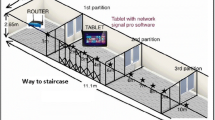Abstract
This paper describes a computer tool for site specific indoor radio channel characterization. The behavior of the electromagnetic fields associated with a base station and a portable radio unit is simulated by combining approximate geometric optics and ray tracing techniques. Given a building plan and the transmitter/receiver locations, the set of all[attenuation / time delay /phase] vectors, each representing an electromagnetic propagation path between transmitter and receiver, is computed using ray shooting techniques to generate the channel wideband impulse response. The model takes into account specular reflection and transmission. Linear polarization and various antenna patterns can be simulated as well. The simulated results are shown to correlate well with experimental data. The computer tool can be used to provide estimates of the coverage of a base station and of the channel quality.
Résumé
Cet article présente un outil informatique pour la caractérisation point par point du canal radio à l’inté rieur de bâtiments. Le comportement des champs électromagnétiques entre une station de base et un terminal mobile est simulé à l’aide d’une approximation d’optique géométrique combinée avec des techniques d’infographie. A partir d’un plan de bâtiment et des positions de l’émetteur et du récepteur, l’ensemble de tous les vecteurs[atténuation, délai, phase], chacun identifiant un trajet de propagation des ondes, est calculé en utilisant des techniques de tracé de rayons afin de produire la réponse impulsionnelle du canal à large bande. Le modèle prend en compte les réflexions spéculaires et les transmissions. Une polarisation rectiligne et l’effet de divers diagrammes d’antennes directionnelles peuvent être également simulés. Il est montré que les prédictions correspondent bien avec les mesures. Ces données permettent d’obtenir une estimation de la couverture de stations de base émettrices et de la qualité du canal radiomobile.
Similar content being viewed by others
References
Hashemi (H.). The indoor radio propagation channel.Proc. IEEE (July 1993),81, no 7, pp. 943–968.
Parsons (J. D.), Demery (D. A.), Turkmani (A. M. D.). Sounding techniques for wideband mobile radio channels: a review.IEE Proc. (Oct. 1991),138, no 5, pp. 437–446.
Ramo (S.), Whinnery (J. R.), Van Duzer (T.). Fields and waves in communication electronics.Wiley, New-York (1965), 754 p.
Wait (J. R.). Introduction to antennas and propagation.Peter Peregrinus Ltd. (1986), 256 p.
Glassner (A.). An introduction to ray tracing.Academic Press (1989), 329 p.
James (G. L.). Geometrical theory of diffraction for electromagnetic waves.IEE (1986).
Ikegami (F.), Takeuchi (T.), Yoshida (S.). Theoretical prediction of mean field strength for urban mobile radio.IEEE Trans. AP (March 1991),39, pp. 299–302.
McKown (J. W.), Hamilton (R. L.). Ray tracing as a design tool for radio networks.IEEE Network Magazine (Nov. 1991),5, n 6, pp. 27–30.
Lawton (M. C.), McGeehan (J. P.). The application of a deterministic ray launching algorithm for the prediction of radio channel characteristics in small-cell environments.IEEE Trans. VT (Nov. 1984),43, no 4, pp. 955–969.
Lawton (M. C.), Me Geehan (J. P.). The application of gtd and ray launching techniques to channel modeling for cordless radio systems.42nd IEEE VTC, Denver (May 1992), pp. 125–130.
Holt (T.), Pahlavan (K.), Lee (J. F.). A graphical indoor radio channel simulator using 2D ray tracing.The 3rd Intern. Symp. Personal Indoor and Mobile Radio Communications, Boston, Ma (Oct. 1992), pp. 13.2.1–13.2.6.
Valenzuela (R. A.). A ray tracing method to predicting indoor wireless transmission.VTC ’93, Secausus, NJ (May 1993), pp. 214–218.
Honcharenko (W.), Bertoni (H. L.), Dailing (J. L.), Qlan (J.), Yee (H. D.). Mechanisms governing uhf propagation on single floors in modern office buildings.IEEE Trans. VT (Nov. 1992),41, no 4, pp. 496–504.
Seidel (S. Y.), Schaubach (K. R.), Tran (T. T.), Rappaport (T. S.). Research in site-specific propagation modeling for PCS system design.VTC’93, Secausus, NJ (May 1993), pp. 261–263.
Schaubach (K. R.), Davis IV (N. J.), Rappaport (T. S.). A ray tracing method for predicting path loss and delay spread in microcellular environments.42nd IEEE VTC, Denver (May 1992), pp. 932–935.
Schaubach (K. R.), Davis IV (N.J.). Microcellular radio-channel propagation prediction.IEEEAPM (Aug. 1994),36, no 4, pp. 25–34.
Seidel (S. Y.), Rappaport (T. S.). A ray tracing technique to predict path loss and delay spread inside buildings.Globecom ’92, Orlando, Florida (Dec. 1992), pp. 649–653.
Seidel (S. Y), Rappaport (T. S.). Site-specific propagation prediction for wireless in-building personal communication system design.IEEE Trans. VT (Nov. 1994),43, no 4, pp. 879–891.
Saleh (A.), Valenzuela (R.). A statistical model for indoor multipath propagation.IEEE JSAC (Feb. 1987),5, n 2, pp. 128–137.
Stutzman (W. L.), Thiele (G. A.). Antenna theory and design.John Wiley & Sons (1981), 598 p.
Rappaport (T. S.). The wireless revolution.IEEE Comm. Mag. (Nov. 1991), pp. 52–71.
Tuttlebee (W.). Cordless telecommunications in Europe.Springer-Verlag (1990), 304 p.
Landron (O.), Feuerstein (M. J.), Rappaport (T. S.). In situ microwave reflection coefficient measurements for smooth and rough exterior wall surfaces.VTC’93, Secausus, NJ (May 1993), pp. 77–80.
Foley (J. D.), Van Dam (A.), Feiner (S. K.), Hughes (J. F.). Computer graphics.Addison-Wesley (1990), 1175 p.
Bultitude (R. J.), Melançon (P.), Zaghloul (H.), Morrison (G.), Prokki (M.). The dependence of indoor radio channel multipath characteristics on transmit/receive ranges.IEEE JSAC (Sep. 1993),11, no 7, pp. 979–990.
Chudobiak (W. J.), Syrett (B. A.), Hafez (H. M.). Recent advances in broad-band vhf and uhf transmission line methods for moisture content and dielectric constant measurement.IEEE Trans. IM (Dec. 1979),28, no 4, pp. 284–289.
Author information
Authors and Affiliations
Additional information
Part of this work was presented at the 2nd International Conference on Universal Personal Communications, Ottawa, Canada, October 1993.
Rights and permissions
About this article
Cite this article
Kimpe, M., Leib, H. Computerized indoor radio channel estimation using ray tracing. Ann. Télécommun. 52, 251–263 (1997). https://doi.org/10.1007/BF02996068
Received:
Accepted:
Issue Date:
DOI: https://doi.org/10.1007/BF02996068
Key words
- Indoor radiocommunication
- Radio channel
- Ray tracing
- Computer aid
- Geometrical optics
- Multipath propagation
- Iteration




